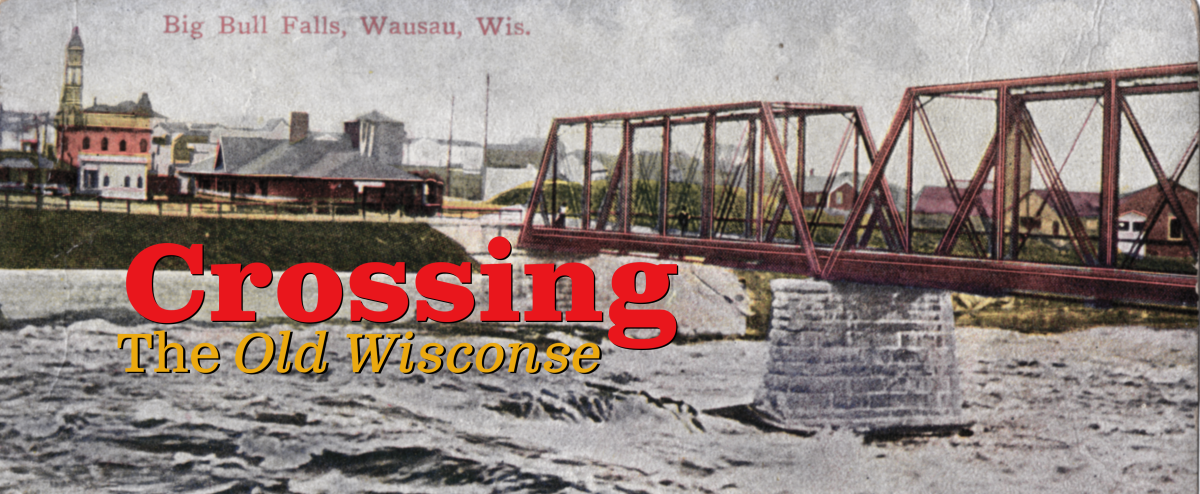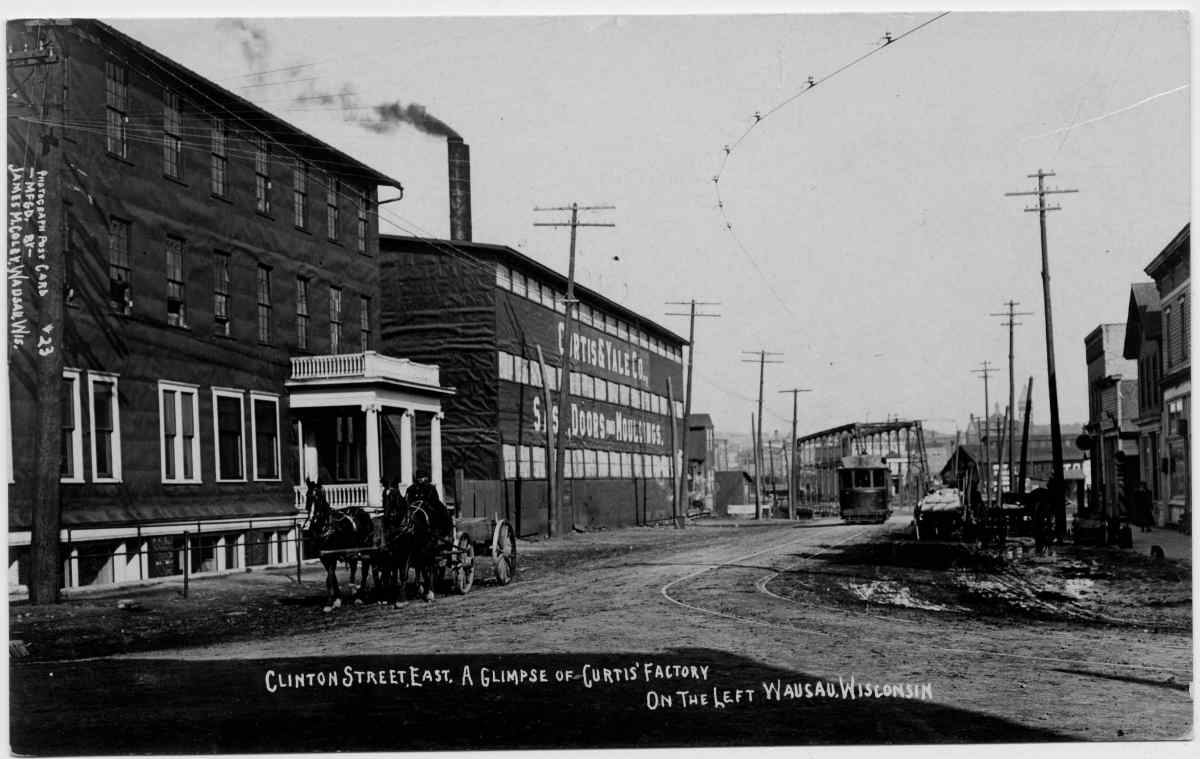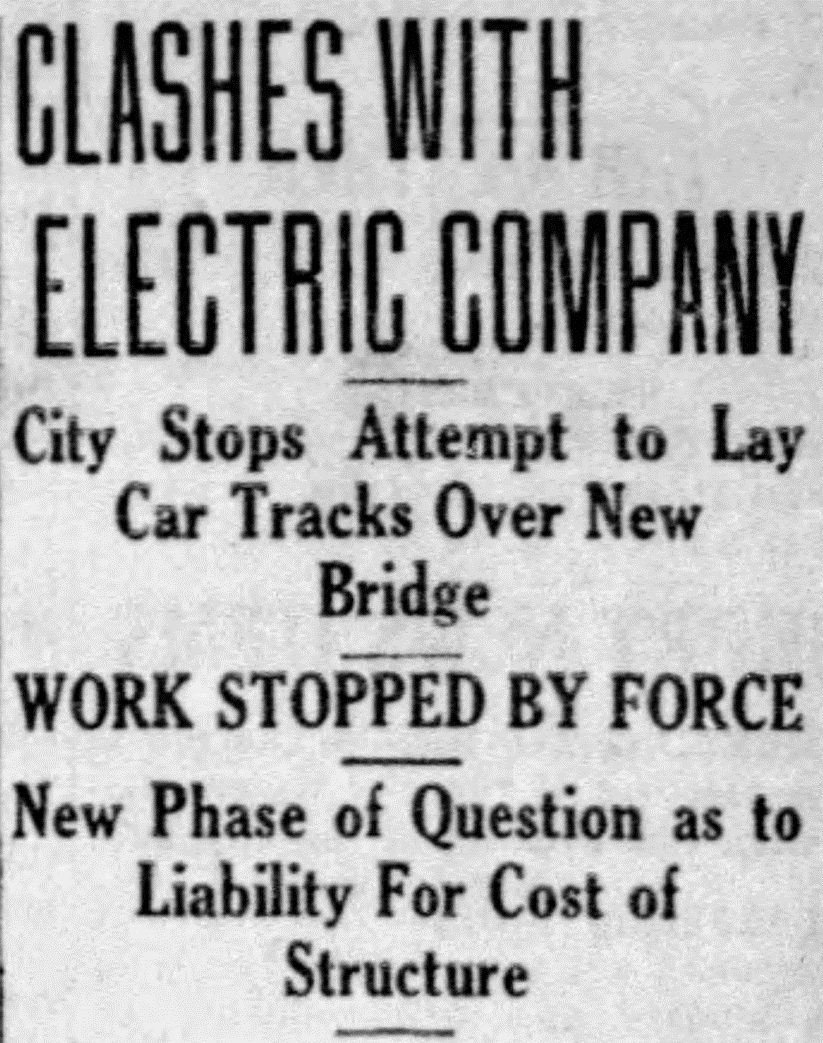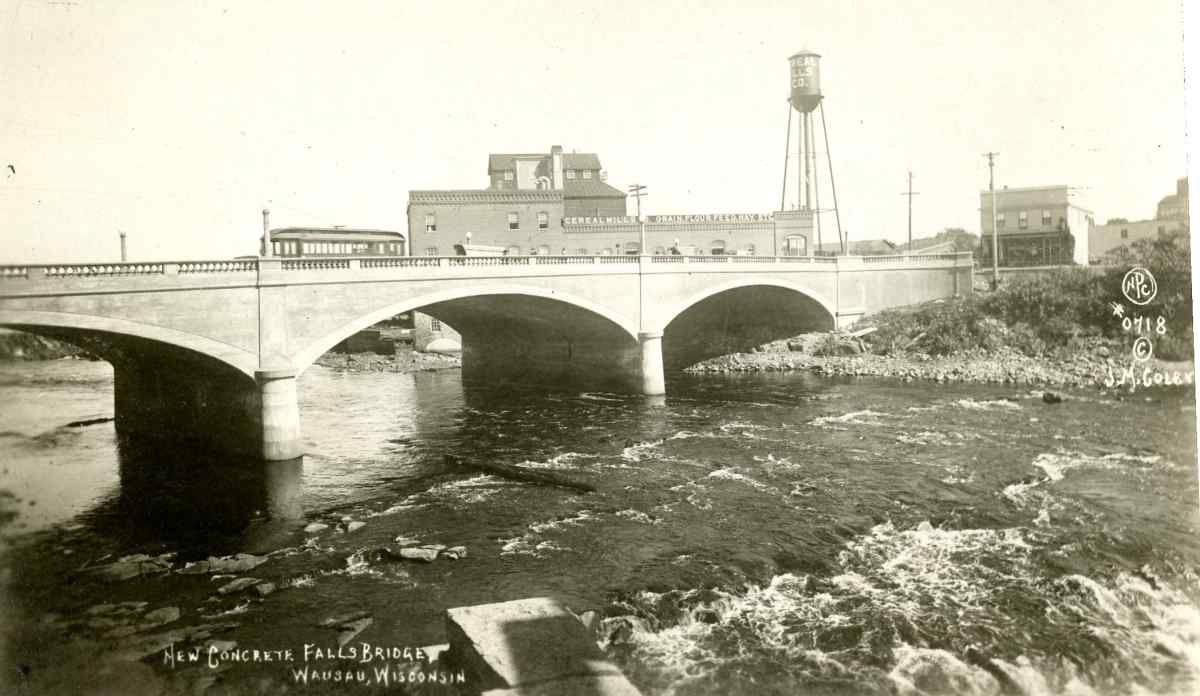The Battle of Falls Bridge

When you think of the process that a municipality goes through to install a new road or bridge you probably picture alderpersons and county officials meeting with contractors, receiving bids, handing out contracts, and coordinating with the county and state roadworks. The overall image is one of orderly bureaucracy without room for dramatics or intrigue. Of course, as with all things involving humans, occasionally proceedings go off the rails and strange things occur. Such was the case in 1918 during the construction of the Falls Bridge in downtown Wausau.

A Wausau Streetcar, having just crossed the Falls Iron Bridge on an East-West connecting service, trundles past the Curtis and Yale Plant on what is today Stewart Avenue.While not as extensive as its East Side counterpart, West Side service was still vital and reached as far as the 3M plant on Thomas Street.
Credit: MCHS Photo Collection
The Struggles of the Street Railroad
In 1912, the Falls Bridge, over the main channel of the Wisconsin River, was in dire need of replacement.1 The bridge had been built in 1883, and subsequently rebuilt and overhauled so many times that even with constant maintenance it was falling apart. The Falls Bridge was also the main artery between East and West Wausau. In addition to road and foot traffic, it also carried the Wisconsin Valley Electric Company’s Street Cars, serving as the railroad’s sole connection to the West side of the city. The WVEC’s Street Railroad had held a franchise to operate cars in the city since 19062 and had been granted a supplementary franchise to operate over Falls Bridge the following year.3 Conditional to the possession of these franchises was that the railroad would assist in the paving and maintenance of the roads on which it operated.4 The requirement to assist in road maintenance was out of an abundance of caution on the part of city officials who were concerned that the street railroad might tear up roads in order to lay their tracks and then expect the city to foot the bill for repaving. The arrangement quickly proved a source of problems. As early as 1907, city officials consistantly clashed with the street railroad, as well as one another, over exactly what the street railroad was expected to contribute to the upkeep of public thoroughfares.5
By 1916, and things were not going smoothly for the street railroad. Increases in operating costs, as well as the rapid development of the automobile,6 were putting an ever-increasing strain on the company. The cost associated with repaving roads meant that the railroad was unable to expand into new areas to keep up with automobiles and a prohibition on increased fares meant that profits remained low.7 Railroad President Mark Ewing stated, “Like the hunter’s bear which he had by the tail, we can neither determine the course nor can we let go, and there seems nothing to do but to hang on and take the bumps and do the best we can.”8 By 1916 the railroad hadn’t established a new line for over a decade.9 Mr. Ewing made it publicly known that the street railroad wished to remain competitive, and had plans to make expansions to its service, but that, “In the meantime too many street improvement burdens should not be insisted upon by the cities. The railroad company does not use the paving of the streets, and it is the paving requirements of cities which to a considerable extent has discouraged and stopped the construction of these lines everywhere." 10
Who's Picking up the Tab?
The street railroad made a concerted effort to move forward with repairs and improvements over the next year, only to hit another roadblock in March of 1917. The Falls Bridge, already known to be in poor condition, was discovered to be at the point of collapse.11 A new bridge would need to be erected and with construction of the new bridge scheduled to start in October service to the west side would have to be discontinued. What’s more, under the terms of the railroad’s franchise, the city believed that it should be required to pay for a portion of the replacement. The street railroad responded to the city’s demands, stating that they had already surrendered their old franchise on the bridge and that in any case the franchise had been drawn up with the understanding that the west-side line would not be sufficiently lucrative for the railroad if it was also expected to contribute to the maintenance of the Falls Bridge.12 Matters were not as simple as that, however, In preparation for the demolition of the old Falls Bridge the Street Railroad had voluntarily surrendered its franchise presumably with the understanding that a similar one would be issued for the new bridge.13 Without the protection of the old franchise, it seemed likely that the street railroad would be stuck with the cost of the bridge.
With a continued stalemate between the city and the street railroad and no agreement in sight, Aldermen contacted the Wisconsin State Railroad Commission in hopes of finding mediation. Instead, they found more confusion as the commission replied that it was unsure of its jurisdiction over the matter and that the outcome depended on whether or not “the old bridge is still in existence and is unsafe and dangerous...” or if “work has proceeded to the point where the new bridge is practically completed or sufficiently so to remove danger to public travel…” at which point it would be too late for the city to force the street railroad to contribute.14 In a February 1918 hearing on the matter, both the Mayor and the City Engineer testified that in the years leading up to the conflict, the bridge had shown severe degradation and had been declared unsafe. In response, Railroad Manager Mark Ewing stated that a load test in preparation for a circus parade in 1916 had shown that the bridge was capable of withstanding an excess of 60,000 pounds.15
From Words to Blows
The Street Railroad was apparently quite confident in their defense as on Jun 13, 1918, without waiting for the Railroad Commission’s ruling, they sent a crew of men to begin laying tracks over the now almost complete bridge.16 The board of public works was notified and convened a hurried meeting with City Attorney F. P. Regner who then instructed Chief of Police Thomas Malone to see that the men were driven off. The workmen vacated the bridge when ordered to do so but continued laying track and stringing wires on the approaches. It was at this time that Manager Mark Ewing made an appearance and after harsh words with city officials, instructed his men to continue. The railroad men again tried to make their way onto the bridge but were met by the police and physically restrained. A shoving match ensued and for a moment it looked as if a brawl would break out until the railroad’s attorney, Mr. C.B. Bird, stepped in and cooler heads prevailed.17

The fight between the Electric Company and Wausau Police made local headlines.
Credit: Wausau Daily Herald June 13, 1918
Shortly after the incident, the city released a statement on the matter. City Attorney Regner stated that he believed the whole affair had been a misunderstanding. The bridge, he said, had been opened to vehicle traffic, and the street railroad must have mistakenly believed that this gave them the right to lay their line across it. In reality, he continued, the bridge had yet to be formally accepted by the city, and the railroad commission had yet to rule on the previous matters regarding payment.18
In response Director Ewing released an altogether less friendly statement.
"We have been asked by City Attorney Frank P. Regner, to defer constructing tracks across the new bridge and operating west side cars over the bridge until the railroad commission has rendered a decision with reference to what, if any portion, of the bridge should be paid for by the Electric company, which proceedings are now pending. We have replied to the city attorney that we did not care to assume the responsibility of delaying the operation of cars to the west side; that if the city or its officials desired to assume the responsibility of indefinitely discontinuing street car service, that we were willing that they should proceed to do so by taking the necessary legal proceedings which seem advisable and that until such proceedings were taken we would proceed to connect up track and operate cars at as early a date as possible, in accordance with our obligations to the public and franchise obligations."19
Ewing went on to address the mayor directly,
"The contractors have advised us that we have their permission to go ahead and restore our track upon the bridge. We started to do so today and the police department forcibly kept us from entering upon the bridge… [we] request that you direct the city police department to permit us to go ahead with this work and that you advice us as soon as the police department are given other instructions than those they now have in this matter."20
The Public Demands Service
Both the scuffle on the bridge and the ensuing arguments received heavy press coverage. The increased public awareness that this generated quickly began to work in the railroad’s favor. Throughout July of 1918 businesses and residents circulated petitions demanding that the street railroad be allowed to reestablish service to the west side and presented the collected signatures to the city council.21 Later that month the railroad commission finally returned a verdict. They refused to rule either way stating they had no authority in the matter but that the involved parties should move to resolve things as soon as possible.22

By 1918, West Side Residents, who had been intently the developments surrounding the bridge, had grown so sick of waiting for the resumption of street car service that they began petitioning on the Electric Company's behalf. Credit: Wausau Daily Herald July 30, 1918
West Side Service Resumes
With no help from the railroad commission and public opinion turning against them, the city council desperately suggested a rental plan in which it would lay its own tracks and charge the street railroad a yearly fee.23 Mr. Ewing, evidently unimpressed by the suggestion responded in a lengthy letter to the effect that the street railroad had been more than reasonable in its dealings with the city and had followed its franchise to the letter despite facing ever increasing costs and ever decreasing profits. If the city wished to continue to be unreasonable then the railroad would be more than happy to discontinue west side service permanently and turn over its equipment to the federal government for use in the war effort.24 With this final ultimatum still ringing in everyone’s ears, Alderman Morisette moved to restore street car service over the bridge and the motion was adopted. A mere ten days later on August 17, 1918, street car service resumed over the falls bridge.25

A street car crosses the newly completed Falls Bridge
Credit: MCHS Photo Collection
< Falls Bridge Main Index Glossary
1. "Bridges in Poor Condition." Wausau Pilot (Wausau), April 5, 1912.
2. "Legal Notices." Wausau Pilot (Wausau), January 2, 1906.
3. “City Council.” Wausau Pilot (Wausau), April 30, 1907.
4. “Notice for Amendment To Street R.R. Franchise.” Wausau Pilot (Wausau), September 12, 1916.
5. “City Council.” Wausau Pilot (Wausau) May 14, 1907.
6. “Troubles of Small Street Railways.” Wausau Daily Herald (Wausau), March 16, 1916.
7. “Notice for Amendment”
8. “Troubles of Small Street Railways.”
9. “Notice for Amendment”
10. “Electric Company To Make Improvements And Extensions Of Street Railroad Lines.” Wausau Pilot (Wausau), March 28, 1916.
11. “The Falls Bridge.” Wausau Pilot (Wausau) March 13, 1917.
12. “Council Discusses Payment For Bridge.” Wausau Daily Herald (Wausau), December 5, 1917
13. “Council Discusses Payment For Bridge”
14. “Council Discusses Payment For Bridge”
15. “Bridge Hearing Was Held Today.” Wausau Daily Herald (Wausau), February 8, 1918
16. “Clashes With Electric Company.” Wausau Daily Herald (Wausau), June 13, 1918.
17. “Clashes With Electric Company”
18. “Clashes With Electric Company”
19. “Clashes With Electric Company”
20. “Clashes With Electric Company”
21. “Want Service.” Wausau Daily Herald (Wausau), July 24, 1918
22. “Decision of the Railroad Commission.” Wausau Daily Herald (Wausau), July 30, 1918
23."Decision of the Railroad Commission"
24. “Street Cars To Use New Bridge.” Wausau Daily Herald (Wausau), August 7, 1918
25. “Traffic Resumed” Wausau Daily Herald (Wausau), August 17, 1918
